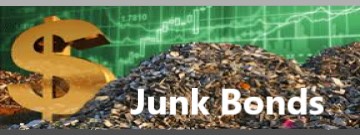
Junk bonds are a form of debt financing that carries with extreme high risk of default. Sometimes referred to as non-investment-grade bonds, speculative-grade bonds, or junk bonds they have carry risk that is higher than most bonds issued by corporations and governments.
Made famous by Michael Milken the instruments were frequently used by the corporate raiders of the 1980’s during hostile takeovers. Starting with a highly confident letter, the hostile takeover would be backed up with a seemingly limitless supply of junk bond financing from Milken. These bonds promise to pay investors interest payments way above the regular market rate in exchange for taking higher risk. Financing is often unsecured so this type of investor class is often the last to be paid back. The level of potential returns however can make these investments attractive to specialist investors.
Rating Junk Bonds
Junk-bond Investments May Entice New Additional investors into the market place as they have the same characteristics as investment grade bonds such as the amount it will pay back, known as the principal. Technically speaking, a junk bond is the same as a regular bond. The date it will pay the principal back, known as the maturity date, and the interest or coupon it will on the funds that are borrowed and the possibility of various covenants are additional similarities. Junk bonds will differ however because of the credit quality of the issuer. What remains as a source of debate is whether “fallen angels”, bonds issued by companies which no longer have a top rated credit rating as before, are considered junk. As at the time of issuance, junk bonds are considered as such as the issuer has no other option.
Their credit ratings are less than pristine, making it difficult for them to acquire capital at an inexpensive cost. As can be seen from the bond rating table below, junk bonds are typically rated ‘BB’ or lower by Standard & Poor’s and ‘Ba’ or lower by Moody’s.
| Moody’s | S&P | Fitch | Rating description | |
|---|---|---|---|---|
| Long-term | Long-term | Long-term | ||
| Aaa | AAA | AAA | Prime | Investment-grade |
| Aa1 | AA+ | AA+ | High grade | |
| Aa2 | AA | AA | ||
| Aa3 | AA− | AA− | ||
| A1 | A+ | A+ | Upper medium grade | |
| A2 | A | A | ||
| A3 | A− | A− | ||
| Baa1 | BBB+ | BBB+ | Lower medium grade | |
| Baa2 | BBB | BBB | ||
| Baa3 | BBB− | BBB− | ||
| Ba1 | BB+ | BB+ | Non-investment grade speculative | Non-investment grade AKA high-yield bonds AKA junk bonds |
| Ba2 | BB | BB | ||
| Ba3 | BB− | BB− | ||
| B1 | B+ | B+ | Highly speculative | |
| B2 | B | B | ||
| B3 | B− | B− | ||
| Caa1 | CCC+ | CCC | Substantial risks | |
| Caa2 | CCC | Extremely speculative | ||
| Caa3 | CCC− | Default imminent with little prospect for recovery | ||
| Ca | CC | |||
| C | ||||
| C | D | DDD | In default | |
| / | DD | |||
| D | ||||
